Given row and column you will need to know the number of columns per row. With this information you can simply do (row * columns) + column which will return the index of the square.
For example, with 8 columns per row, a request for
row = 0, column = 4, will return 4row = 1, column = 4, will return 12row = 0, column = 0, will return 0
Rendering the sections of the square is more complex and can be achieved in at least two ways. You could use a Polygon which generates a triangle for each section or Shape and simply use Graphics2D#fill to fill it.
This will come down to how you physically render each square...
Take a look at 2D Graphics for more details and this for an example of both.
A Shape would be much easier to rotate and position and would only require you to have a single instance (or a single instance for each square based on your needs), where as you would require at least 4 Polygons or do some fun rotation...
Updated with simple example
All done with rotating triangles...

import java.awt.BorderLayout;
import java.awt.Color;
import java.awt.Dimension;
import java.awt.EventQueue;
import java.awt.FontMetrics;
import java.awt.Graphics;
import java.awt.Graphics2D;
import java.awt.Point;
import java.awt.Rectangle;
import java.awt.Shape;
import java.awt.geom.AffineTransform;
import java.awt.geom.Path2D;
import java.awt.geom.Point2D;
import javax.swing.JFrame;
import javax.swing.JPanel;
import javax.swing.UIManager;
import javax.swing.UnsupportedLookAndFeelException;
public class DividedSquare {
public static void main(String[] args) {
new DividedSquare();
}
public DividedSquare() {
EventQueue.invokeLater(new Runnable() {
@Override
public void run() {
try {
UIManager.setLookAndFeel(UIManager.getSystemLookAndFeelClassName());
} catch (ClassNotFoundException | InstantiationException | IllegalAccessException | UnsupportedLookAndFeelException ex) {
}
JFrame frame = new JFrame("Testing");
frame.setDefaultCloseOperation(JFrame.EXIT_ON_CLOSE);
frame.setLayout(new BorderLayout());
frame.add(new TestPane());
frame.pack();
frame.setLocationRelativeTo(null);
frame.setVisible(true);
}
});
}
public class TestPane extends JPanel {
private TriangleShape baseTriangle;
private Color[] colors;
public TestPane() {
colors = new Color[]{Color.RED, Color.GREEN, Color.BLUE, Color.MAGENTA};
}
@Override
public void invalidate() {
super.invalidate();
baseTriangle = new TriangleShape(
new Point(0, 0),
new Point(getWidth(), 0),
new Point(getWidth() / 2, getHeight() / 2));
}
@Override
public Dimension getPreferredSize() {
return new Dimension(200, 200);
}
@Override
protected void paintComponent(Graphics g) {
super.paintComponent(g);
Graphics2D g2d = (Graphics2D) g.create();
String text[] = new String[]{
"123.123",
"456.789",
"012.315",
"678.921"
};
FontMetrics fm = g2d.getFontMetrics();
double angel = 0;
for (int index = 0; index < 4; index++) {
g2d.setColor(colors[index]);
Path2D rotated = rotate(baseTriangle, angel);
g2d.fill(rotated);
Rectangle bounds = rotated.getBounds();
int x = bounds.x + ((bounds.width - fm.stringWidth(text[0])) / 2);
int y = bounds.y + (((bounds.height - fm.getHeight()) / 2) + fm.getAscent());
g2d.setColor(Color.WHITE);
g2d.drawString(text[index], x, y);
angel += 90;
}
g2d.setColor(Color.BLACK);
g2d.drawLine(0, 0, getWidth(), getHeight());
g2d.drawLine(getWidth(), 0, 0, getHeight());
g2d.dispose();
}
public Path2D rotate(TriangleShape shape, double angel) {
Rectangle bounds = shape.getBounds();
int x = bounds.width / 2;
int y = bounds.width / 2;
return new Path2D.Float(shape, AffineTransform.getRotateInstance(
Math.toRadians(angel),
x,
y));
}
}
public class TriangleShape extends Path2D.Double {
public TriangleShape(Point2D... points) {
moveTo(points[0].getX(), points[0].getY());
lineTo(points[1].getX(), points[1].getY());
lineTo(points[2].getX(), points[2].getY());
closePath();
}
}
}


 ...
...